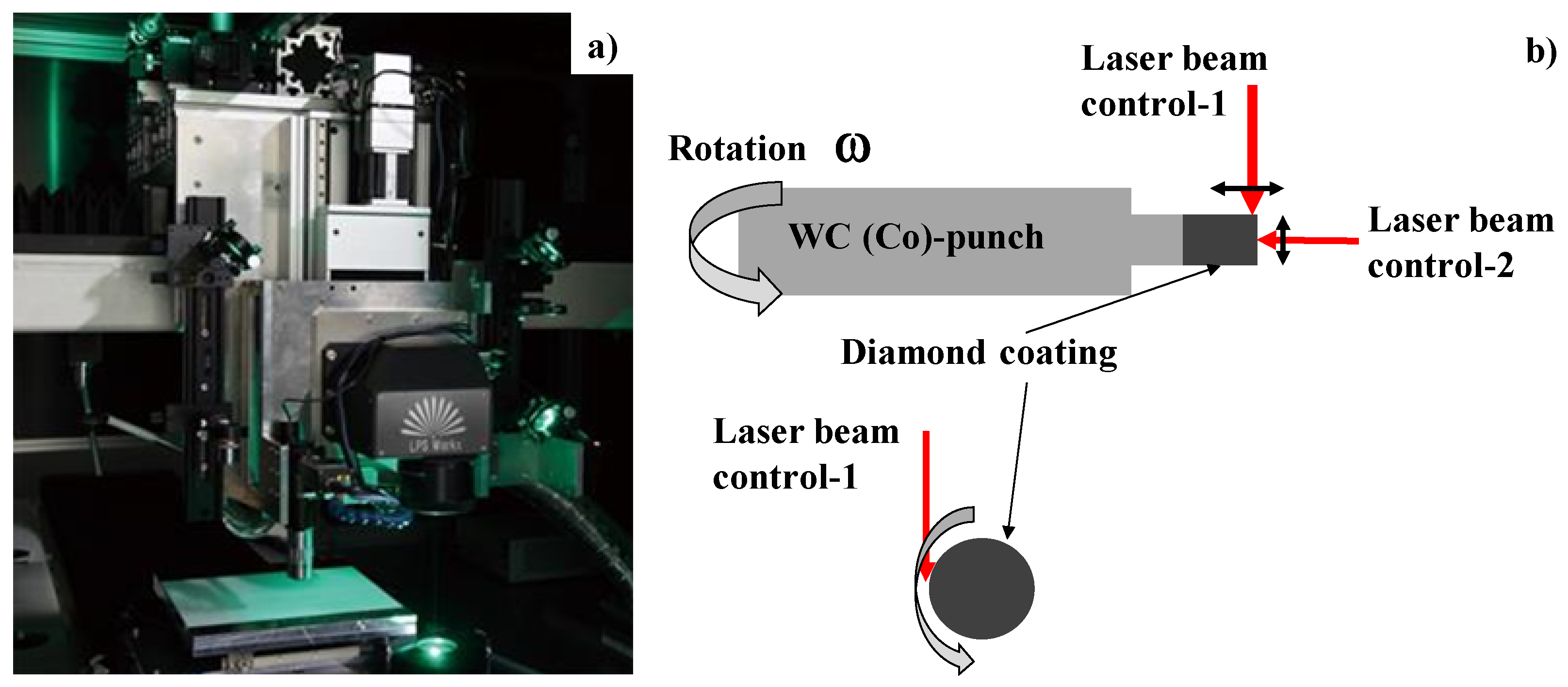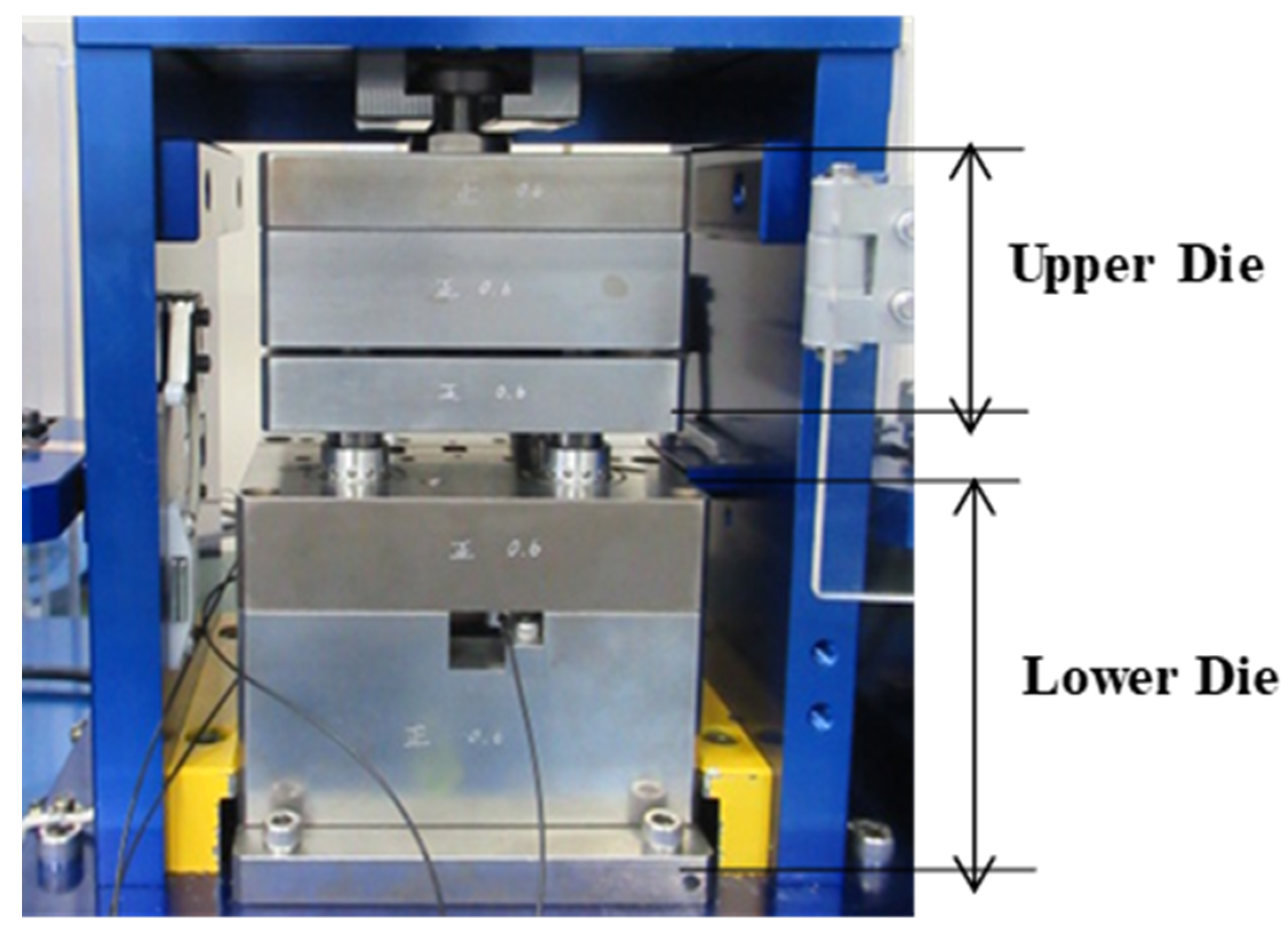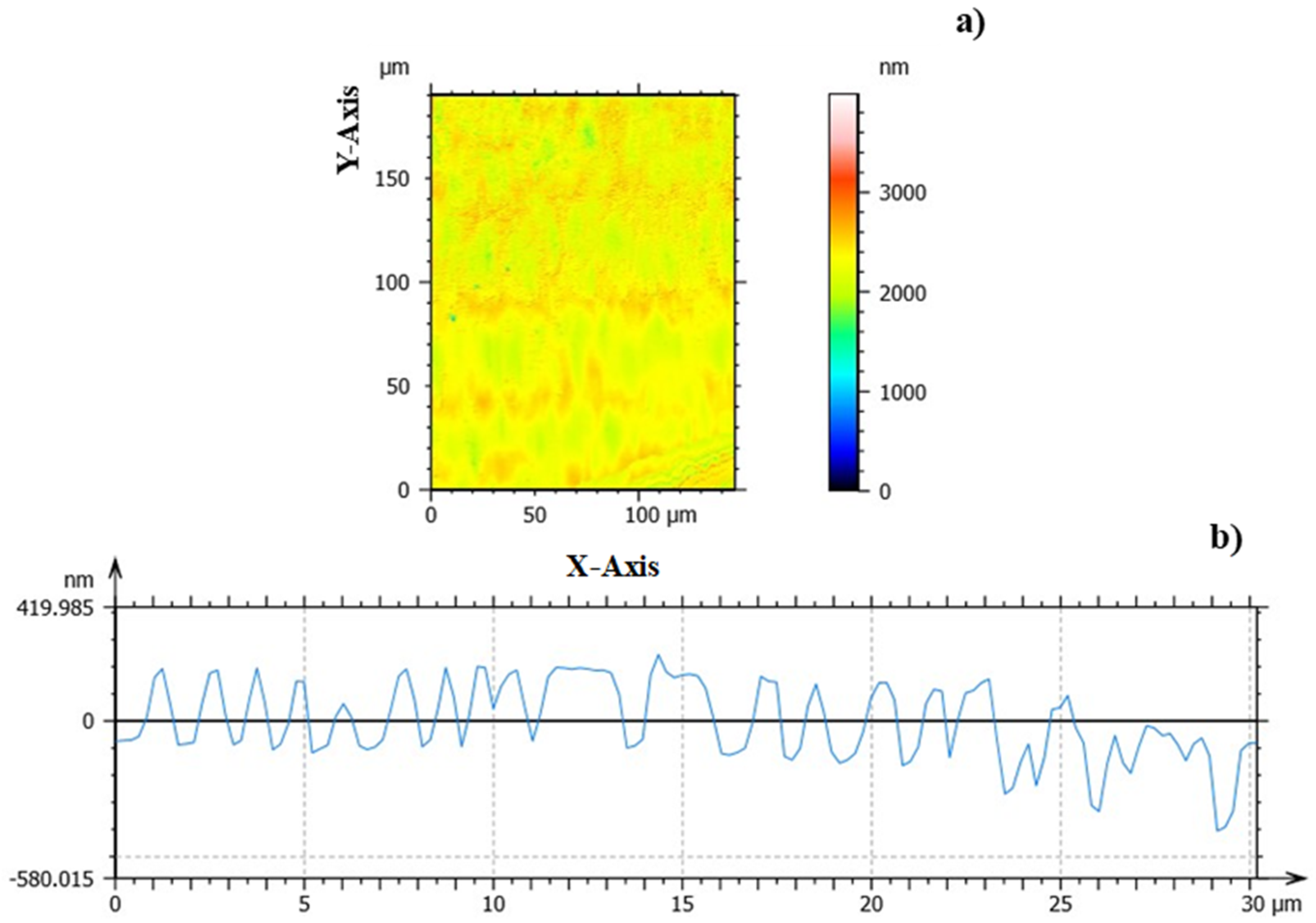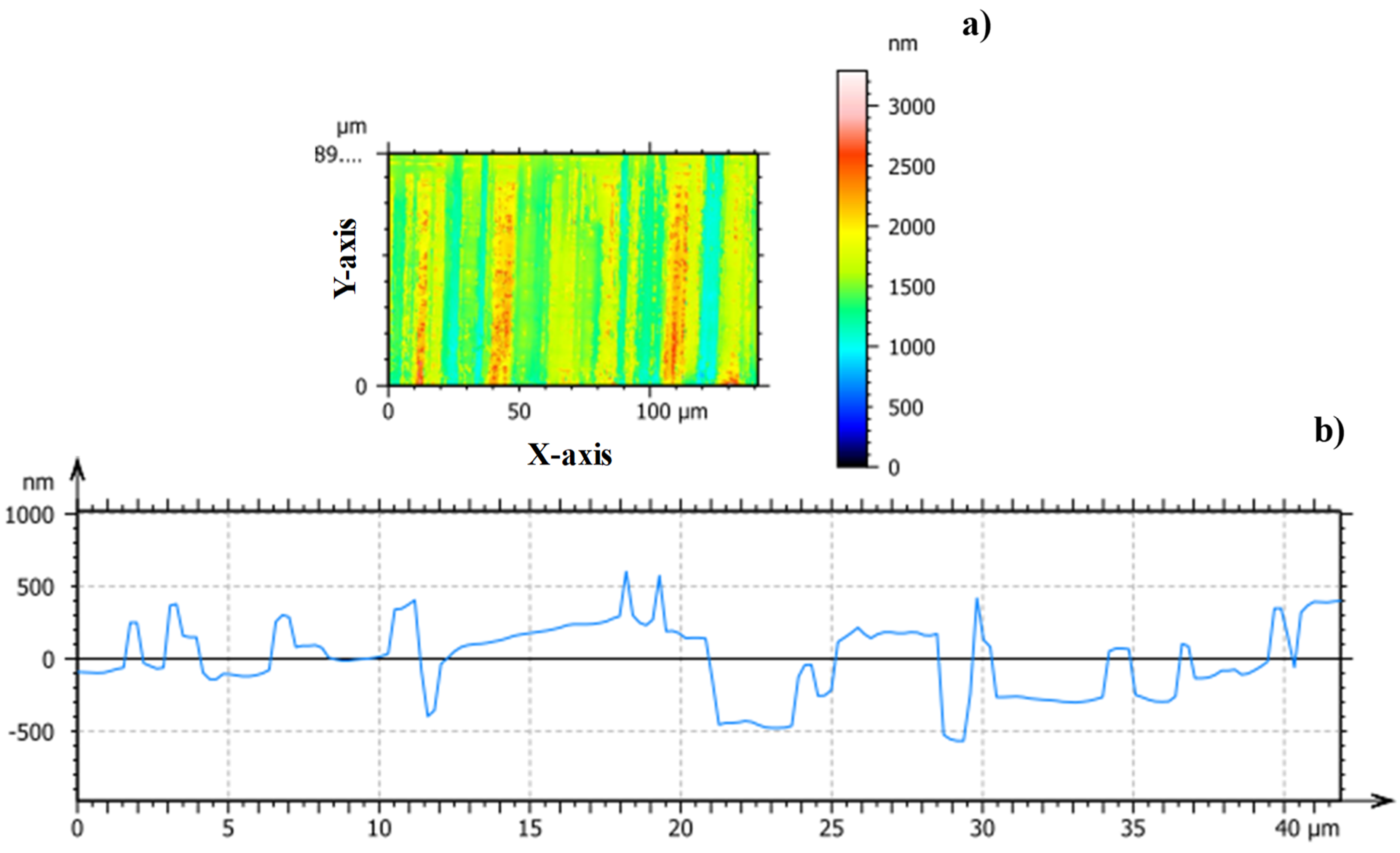Simultaneous Nano-Texturing onto a CVD-Diamond Coated Piercing Punch with Femtosecond Laser Trimming
Abstract
:Featured Application
Abstract
1. Introduction
2. Experimental Procedure
2.1. Femtosecond Laser Trimming System
2.2. Laser Trimming Procedure
2.3. Fine Stamping System
3. Experimental Results
3.1. Simultaneous Nanotexturing with Femtosecond Laser Trimming
3.2. Concurrent Transcription of the Nanotextures onto the Hole Surfaces with Piercing
4. Discussion
5. Conclusions
Author Contributions
Funding
Acknowledgments
Conflicts of Interest
References
- Huynh, T.A.; Hsieh, M.-F. Performance evaluation of thin electrical steels applied to interior permanent magnet motor. In Proceedings of the 2016 19th International Conference on Electrical Machines and Systems (ICEMS), Chiba, Japan, 13–16 November 2016; pp. 1–6. [Google Scholar]
- Precise Production of Electrical Steel Motor Cores. Available online: https://www.kuroda-precision.co.jp/products/lp/ (accessed on 24 February 2020).
- Prolongation of Piercing Punches. Available online: https://americanpunchco.com/PDFs/American-Punch-Punch-Tips.pdf (accessed on 24 February 2020).
- Aizawa, T.; Katsuta, E.; Shiratori, T.; Dohda, K. Fine piercing of electromagnetic steel sheets by the plasma nitrided tools. Procedia Eng. 2017, 207, 1027–1032. [Google Scholar] [CrossRef]
- Yunata, E.E.; Aizawa, T. Micro-texturing into DLC/diamond coated molds and dies via high density oxygen plasma etching. Manuf. Rev. 2015, 2, 13. [Google Scholar] [CrossRef] [Green Version]
- Shiratori, T.; Aizawa, T.; Nakano, S.; Kato, T. Piercing Punch and Die, Their Fabrication and Shaping Methods, and Wrought Products. Japan Patent #2019-79948 2019, 27 September 2019. [Google Scholar]
- Katsuta, E.; Aizawa, T.; Morita, H.; Dohda, K.; Anzai, M. Fine piercing of electromagnetic steel sheets by micro-punches under nearly zero clearance. Procedia Manuf. 2018, 15, 1459–1466. [Google Scholar] [CrossRef]
- Katsuta, E.; Aizawa, T.; Dohda, K.; Yoshihara, S.-I. Fabrication of lower temperature plasma-nitrided die and development of zero clearance piercing of electromagnetic sheets. J. Jpn. Soc. Technol. Plast. 2019, 60, 70–75. [Google Scholar] [CrossRef]
- Aizawa, T.; Inohara, T. Geometric adjustment and sizing of CVD-diamond coatings via oxygen plasma etching and laser machining. In Proceedings of the 7th SEATUC Conference, (Bandon, 2013) CD-ROM, Bandung, Indonesia, 5–6 March 2013. [Google Scholar]
- Aizawa, T.; Shiratori, T.; Inohara, T. Short-pulse laser precise trimming of CVD-diamond coated punch for fine piercing. In Proceedings of the 2nd Asian Pacific Symposium on Technology of Plasticity (APSTP) 2019, Tokyo, Japan, 31 July–3 August 2019; pp. 123–128. [Google Scholar]
- Aizawa, T.; Shiratori, T.; Yoshino, T.; Inohara, T. Femtosecond laser trimming of CVD-diamond coated punch for fine embossing. Mater. Trans. 2020, 61, 244–250. [Google Scholar] [CrossRef]
- van Driel, H.M.; Sipe, J.E.; Young, J.F. Laser-induced periodic surface structure on solids: A universal phenomenon. Phys. Rev. Lett. 1982, 49, 1955–1958. [Google Scholar] [CrossRef]
- Aizawa, T.; Inohara, T. Pico- and femtosecond laser micromachining for surface texturing. In Micromachining; Intech Open: London, UK, 2019; pp. 1–24. [Google Scholar]
- Le Harzic, R.; Stracke, F.; Zimmermann, H. Formation mechanism of femtosecond laser-induced high spatial frequency ripples on semiconductors at low fluence and high repetition rate. J. Appl. Phys. 2013, 113, 183503–183511. [Google Scholar] [CrossRef] [Green Version]
- Hashida, M. Nano-ablation of materials interacted with femtosecond laser pulses. J. Plasma Fusion Res. 2018, 94, 244–248. [Google Scholar]
- Das, S.K.; Messaoudi, H.; Debroy, A.; McGlynn, E.; Grunwald, R. Multiphoton excitation of surface plasmon-polaritons and scaling of nanoripple formation in large bandgap materials. Opt. Mater. Express 2013, 3, 17051715. [Google Scholar] [CrossRef] [Green Version]
- Aizawa, T.; Inohara, T.; Wasa, K. Fabrication of superhydrophobic stainless steel nozzles by femtosecond laser micro-/nano-texturing. Int. J. Autom. Technol. 2020, 14, 159–165. [Google Scholar] [CrossRef]
- de Groot, P. Principles of interference microscopy for the measurement of surface topography. Adv. Opt. Photonics 2015, 7, 1–65. [Google Scholar] [CrossRef]
- Fine Blanking Technology. Available online: https://www.feintool.com/en/technology/fineblanking/ (accessed on 24 February 2020).
- Biglari, F.R.; Kermani, A.T.; Parsa, M.H.; Nikbin, K.M.; O’dowd, N.P. Comparison of fine and conventional blanking based on ductile fracture criteria. In Proceedings of the ASME 7th Biennial Conf. Engineering Systems Design and Analysis, Manchester, UK, 19–22 July 2004; pp. 265–270. [Google Scholar]
- Shiratori, T.; Yoshino, T.; Suzuki, Y.; Katoh, M.; Nakano, S.; Yang, M. Deformation and transformation behavior in micropiercing of SUS304. Procedia Manuf. 2018, 15, 1452–1458. [Google Scholar] [CrossRef]
- Gecys, P.; Vinciunas, A.; Gedvilas, M.; Kasparaitic, A.; Lazdinas, R.; Raciukaitis, G. Ripple formation by femtosecond laser pulses for enhanced absorptance of stainless steel. J. Laser Micro Nanoeng. 2015, 10, 129–133. [Google Scholar] [CrossRef]
- He, X.; Datta, A.; Nam, W.; Traverso, L.M.; Xu, X. Sub-diffraction limited writing based on laser induced periodic surface structures. Sci. Rep. 2016, 6, 35035. [Google Scholar] [CrossRef] [PubMed]
- Sugihara, T.; Enomoto, T. Performance of cutting tools with dimple textured surfaces: Comparative study of different texture patterns. J. Inter. Soc. Precis. Eng. Nanotechnol. 2017, 49, 52–60. [Google Scholar] [CrossRef]











© 2020 by the authors. Licensee MDPI, Basel, Switzerland. This article is an open access article distributed under the terms and conditions of the Creative Commons Attribution (CC BY) license (http://creativecommons.org/licenses/by/4.0/).
Share and Cite
Aizawa, T.; Shiratori, T.; Kira, Y.; Inohara, T. Simultaneous Nano-Texturing onto a CVD-Diamond Coated Piercing Punch with Femtosecond Laser Trimming. Appl. Sci. 2020, 10, 2674. https://doi.org/10.3390/app10082674
Aizawa T, Shiratori T, Kira Y, Inohara T. Simultaneous Nano-Texturing onto a CVD-Diamond Coated Piercing Punch with Femtosecond Laser Trimming. Applied Sciences. 2020; 10(8):2674. https://doi.org/10.3390/app10082674
Chicago/Turabian StyleAizawa, Tatsuhiko, Tomomi Shiratori, Yoshihiro Kira, and Tadahiko Inohara. 2020. "Simultaneous Nano-Texturing onto a CVD-Diamond Coated Piercing Punch with Femtosecond Laser Trimming" Applied Sciences 10, no. 8: 2674. https://doi.org/10.3390/app10082674




